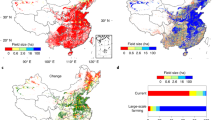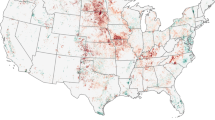Abstract
Cropland fragmentation contributes to low productivity and high abandonment risk. Using spatial statistics on a detailed land use map, we show that 10% of Chinese croplands have no potential to be consolidated for large-scale farming (>10 ha) owing to spatial constraints. These fragmented croplands contribute only 8% of total crop production while using 15% of nitrogen fertilizers, leading to 12% of fertilizer loss in China. Optimizing the cropping structure of fragmented croplands to meet animal food demand in China can increase animal food supply by 19%, equivalent to increasing cropland proportionally. This crop-switching approach would lead to a 10% and 101% reduction in nitrogen and greenhouse gas emissions, respectively, resulting in a net benefit of US$ 7 billion yr−1. If these fragmented croplands were relocated to generate large-scale farming units, livestock, vegetable and fruit production would be increased by 8%, 3% and 14%, respectively, and reactive nitrogen and greenhouse gas emissions would be reduced by 16% and 5%, respectively, resulting in a net benefit of US$ 44 billion yr−1. Both solutions could be used to achieve synergies between food security, economic benefits and environmental protection through increased agricultural productivity, without expanding the overall cropland area.
This is a preview of subscription content, access via your institution
Access options
Access Nature and 54 other Nature Portfolio journals
Get Nature+, our best-value online-access subscription
$29.99 / 30 days
cancel any time
Subscribe to this journal
Receive 12 digital issues and online access to articles
$119.00 per year
only $9.92 per issue
Buy this article
- Purchase on Springer Link
- Instant access to full article PDF
Prices may be subject to local taxes which are calculated during checkout






Similar content being viewed by others
Data availability
Data supporting the findings of this study are available within the article and its supplementary information files. Land use and digital elevation model data were extracted from an online database. Nitrogen cycle data were derived from the Agricultural Pollution Source Census of China in 2017. Records of harvest area and yield of cropland are from the Agricultural Statistics Yearbook 2018. Source data are provided with this paper.
References
Cui, Z. et al. Pursuing sustainable productivity with millions of smallholder farmers. Nature 555, 363–366 (2018).
Cohn, A. S., VanWey, L. K., Spera, S. A. & Mustard, J. F. Cropping frequency and area response to climate variability can exceed yield response. Nat. Clim. Change 6, 601–604 (2016).
Ren, C. et al. Ageing threatens sustainability of smallholder farming in China. Nature 616, 96–103 (2023).
FAOSTAT (FAO, 2021).
Zhao, H. et al. China’s future food demand and its implications for trade and environment. Nat. Sustain. 4, 1042–1051 (2021).
The State Council of PRC The Opinions of the CPC Central Committee and the State Council on Comprehensively Promoting the Key Work of Rural Revitalization in 2023 (China Xinhua News Agency, 2023).
Duan, J. et al. Consolidation of agricultural land can contribute to agricultural sustainability in China. Nat. Food 2, 1014–1022 (2021).
Wang, S. et al. Urbanization can benefit agricultural production with large-scale farming in China. Nat. Food 2, 183–191 (2021).
Jia, L. et al. Effects of minimum soil disturbance practices on controlling water erosion in China’s slope farmland: a meta-analysis. Land Degrad. Dev. 30, 706–716 (2019).
Wang, S. et al. Characteristics of nitrogen loss in sloping farmland with purple soil in southwestern China during maize (Zea mays L.) growth stages. Catena 182, 104169 (2019).
Deng, C. et al. Advantages and disadvantages of terracing: a comprehensive review. Int. Soil Water Conserv. Res. 9, 344–359 (2021).
Mitchell, M. G. E. et al. Reframing landscape fragmentation’s effects on ecosystem services. Trends Ecol. Evol. 30, 190–198 (2015).
Latruffe, L. & Piet, L. Does land fragmentation affect farm performance? A case study from Brittany, France. Agric. Syst. 129, 68–80 (2014).
Pretty, J. et al. Global assessment of agricultural system redesign for sustainable intensification. Nat. Sustain. 1, 441–446 (2018).
Rising, J. & Devineni, N. Crop switching reduces agricultural losses from climate change in the United States by half under RCP 8.5. Nat. Commun. 11, 4991 (2020).
Beyer, R. M., Hua, F., Martin, P. A., Manica, A. & Rademacher, T. Relocating croplands could drastically reduce the environmental impacts of global food production. Commun. Earth. Environ. 3, 49 (2022).
Lowder, S. K., Skoet, J. & Raney, T. The number, size, and distribution of farms, smallholder farms, and family farms worldwide. World Dev. 87, 16–29 (2016).
Abubakar, M. S., Ahmad, D. & Akande, F. B. A review of farm tractor overturning accidents and safety. J. Sci. Technol. 18, 377–385 (2010).
Lark, T. J., Spawn, S. A., Bougie, M. & Gibbs, H. K. Cropland expansion in the United States produces marginal yields at high costs to wildlife. Nat. Commun. 11, 4295 (2020).
Liu, J. et al. Influential factors and classification of cultivated land fragmentation, and implications for future land consolidation: a case study of Jiangsu Province in eastern China. Land Use Policy 88, 104185 (2019).
Ren, C., Zhang, X., Reis, S. & Gu, B. Socioeconomic barriers of nitrogen management for agricultural and environmental sustainability. Agric. Ecosyst. Environ. 333, 107950 (2022).
GAC Proc. Import and Export Quantity and Amount of Vegetables, Fruits, Grain, Meat, Aquatic Products and Dairy Products in China in 2017–2021 (General Administration of Customs of the People’s Republic of China, 2022).
MARA Proc. The 14th Five-Year Plan for the Development of the National Feed Grass Industry (Ministry of Agriculture and Rural Affairs of the People’s Republic of China, 2022).
Cheng, L. et al. A 12% switch from monogastric to ruminant livestock production can reduce emissions and boost crop production for 525 million people. Nat. Food 3, 1040–1051 (2022).
Wang, C. et al. Ammonia emissions from croplands decrease with farm size in China. Environ. Sci. & Technol. 56, 9915–9923 (2022).
NDRC China Agricultural Products Cost–Benefit Yearbook 2018 (China Statistics Press, 2019).
Sikor, T., Müller, D. & Stahl, J. Land fragmentation and cropland abandonment in Albania: implications for the roles of state and community in post-socialist land consolidation. World Dev. 37, 1411–1423 (2009).
General Office of the State Council Proc. Opinions on Guiding the Orderly Transfer of Rural Land Management Rights and Developing Appropriate Scaled Agricultural Operation (China Xinhua News Agency, 2014).
Bryan, B. A. et al. China’s response to a national land-system sustainability emergency. Nature 559, 193–204 (2018).
China’s ‘Grain for Green’ Program of 20 Years (National Forestry and Grassland Administration of the People’s Republic of China, 2020).
NDRC Proc. National Land Consolidation Plan (2016–2020) (National Development and Reform Commission of the People’s Republic of China, 2017).
General Office of the State Council Proc. Opinions on the Prevention of Cropland Conversion to Stabilize Food Production (Central People’s Government of the People’s Republic of China, 2020).
Li, X. et al. Effects of different organic fertilizers on improving soil from newly reclaimed land to crop soil. Agriculture 11, 560 (2021).
Xu, E., Zhang, H. & Xu, Y. Exploring land reclamation history: soil organic carbon sequestration due to dramatic oasis agriculture expansion in arid region of Northwest China. Ecol. Indic. 108, 105746 (2020).
Xu, Y. et al. Effects of agricultural reclamation on soil physicochemical properties in the mid-eastern coastal area of China. Land 10, 142 (2021).
Ren, C. et al. Climate change unequally affects nitrogen use and losses in global croplands. Nat. Food 4, 294–304 (2023).
Yang, S. et al. Warming-induced northwestward migration of the East Asian monsoon rain belt from the Last Glacial Maximum to the mid-Holocene. Proc. Natl Acad. Sci. USA 112, 13178–13183 (2015).
Yu, L. et al. Using a global reference sample set and a cropland map for area estimation in China. Sci. China Earth Sci. 60, 277–285 (2017).
Wei, Z., Bai, Z., Lin, M. & Zhang, F. Spatial characteristics of nitrogen and phosphorus flow in cultivated grassland of China. Sci. Agric. Sin. 51, 535–555 (2018).
Ma, R. et al. Global soil-derived ammonia emissions from agricultural nitrogen fertilizer application: a refinement based on regional and crop-specific emission factors. Glob. Change Biol. 27, 855–867 (2021).
Wei, Z., Hoffland, E., Zhuang, M., Hellegers, P. & Cui, Z. Organic inputs to reduce nitrogen export via leaching and runoff: a global meta-analysis. Environ. Pollut. 291, 118176 (2021).
The National High-Standard Farmland Construction Plan (2021–2030) (Ministry of Agriculture and Rural Affairs, 2021).
2019 Refinement to the 2006 IPCC Guidelines for National Greenhouse Gas Inventories (Intergovernmental Panel on Climate Change, 2019).
Guide to PAS 2050: How to Assess the Carbon Footprint of Goods and Services (British Standards, 2008).
Zhao, J., Cao, Y., Ma, J. & Jiang, Y. Evaluation of NPP and ecological service function of China’s forest ecosystem based on remote sensing and FORCCHN. Ecol. Environ. Sci. 27, 1585–1592 (2018).
NDRC Proc. Provincial Greenhouse Gas Inventory Guidelines (National Development and Reform Commission of the People’s Republic of China, 2011).
MARA China Agriculture Yearbook 2018 (China Agriculture Press, 2019).
Yang, Y., Wang, G. & Pan, X. China Food Composition (Peking Univ. Medicine College Press, 2007).
Zhang, X. et al. Societal benefits of halving agricultural ammonia emissions in China far exceed the abatement costs. Nat. Commun. 11, 4357 (2020).
State and Trends of Carbon Pricing 2021 (World Bank, 2021).
Pinder, R. W. et al. Climate change impacts of US reactive nitrogen. Proc. Natl Acad. Sci. USA 109, 7671–7675 (2012).
Acknowledgements
B.G. acknowledged funding from the National Natural Science Foundation of China (42325707 and 42261144001) and National Key Research and Development Project of China (2022YFE0138200). O.P. acknowledged funding from the National Natural Science Foundation of China (42361144855).
Author information
Authors and Affiliations
Contributions
B.G. conceived the study. O.D. and J.R. conducted the future modelling and identified the fragmented croplands. O.D. and S.H. estimated the nitrogen cycle. J.D. compiled raw data from the agricultural pollution census. O.D. and B.G. wrote the first draft, and S.R., J.Z., Y.-G.Z. and J.X. revised the paper.
Corresponding author
Ethics declarations
Competing interests
The authors declare no competing interests.
Peer review
Peer review information
Nature Food thanks Xiaolong Wang, Yan Xu and the other, anonymous, reviewer(s) for their contribution to the peer review of this work.
Additional information
Publisher’s note Springer Nature remains neutral with regard to jurisdictional claims in published maps and institutional affiliations.
Supplementary information
Supplementary Information
Supplementary Method, Notes, Figs. 1–11 and Tables 1–3.
Source data
Source Data Fig. 1
The area of country-level large-scale cropland (≥10 ha) and fragmented cropland (<10 ha), as well as the yields, fertilizer use and nitrogen loss from these two types of cropland.
Source Data Fig. 2
The area of fragmented cropland at the country level that intersects with grassland, built-up land and forest land, respectively.
Source Data Fig. 3
The differences in yields between national and county scales across various scenarios.
Source Data Fig. 4
National nitrogen budget under different scenarios and differences in nitrogen loss across scenarios at the county level.
Source Data Fig. 5
National GHG emissions from the full-chain production of fragmented cropland and differences in GHG emissions across scenarios at the county level.
Source Data Fig. 6
National cost and benefit of managing fragmented croplands under different scenarios.
Rights and permissions
Springer Nature or its licensor (e.g. a society or other partner) holds exclusive rights to this article under a publishing agreement with the author(s) or other rightsholder(s); author self-archiving of the accepted manuscript version of this article is solely governed by the terms of such publishing agreement and applicable law.
About this article
Cite this article
Deng, O., Ran, J., Huang, S. et al. Managing fragmented croplands for environmental and economic benefits in China. Nat Food 5, 230–240 (2024). https://doi.org/10.1038/s43016-024-00938-7
Received:
Accepted:
Published:
Issue Date:
DOI: https://doi.org/10.1038/s43016-024-00938-7
This article is cited by
-
Contribution of fragmented croplands
Nature Food (2024)



